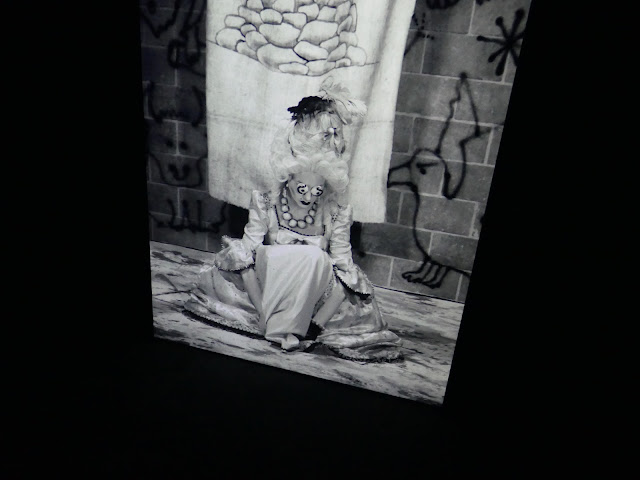La Ferme du Buisson in Noisiel, Justin Fitzpatrick and some nice surprises...
Noisiel is a suburb on the RER A line between Paris and Disneyland, now part of the Marne-la-Vallée new town. Its main claim to fame is a magnificent, metal-framed, water-powered factory with polychrome brickwork, the Moulin Saulnier (1872), thrown, Chenonceaux-style, across the river Marne for Chocolat Menier.
The industrial-scale dairy farm that supplied the chocolate factory, in its day the world's largest, is now an arts complex, with a national theatre, a cinema, a mediatheque and exhibition halls: La Ferme du Buisson.
I'd never previously set foot in Noisiel, but was drawn there last week, on a warm spring day and in excellent company, by Ballotta, an exhibition of characteristically impressive, carefully-crafted paintings and sculptures by the young Irish artist Justin Fitzpatrick (previously shown at the Seventeen Gallery in London: this link takes you to the presentation text and photos on the gallery's website).Anyone who knows Fitzpatrick's work will understand me if I say it might have been even better had his work been shown in the factory itself, rather than the modern, white-painted exhibition rooms of the farm: an old industrial setting would chime with its instantly-recognisable style. His work inhabits, or I should probably say creates, an intriguing, unsettling world of its own, made by transforming a multitude of familiar references from our collective memories - i.e. from the past: folk arts and crafts, gothic, art-nouveau, even steampunk elements, art-déco posters, Soviet realism and so on - sometimes combined with enigmatic text in elaborate, old-fashioned typefaces, that inevitably resonate with us, as what Fitzpatrick calls 'metaphors', when assembled in a new way, raising contemporary questions.
Here are a few of my photos. After them, I'll move on to the nice surprises.
So, those surprises. France's regions have what are called 'FRAC', regional contemporary art deposits that can be plunged into for exhibitions, and in an upstairs room, the Ferme du Buisson had a small group show, in collaboration with the Paris area (Ile de France) FRAC, called La chambre à échos, Vieilles coques et jeunes récifs. Here, one piece in particular caught my eye: Monk (3), by Carlotta Bailly-Borg. I'd have been very happy to take it home with me.
And then, on the other side of the exhibition hall, under the eaves, there was a video installation by Mary Reid Kelley and Patrick Kelley, called Best Femmes Forever. I don't usually expect to be gripped by videos in exhibitions; neither photography nor video are really my 'thing'. But there are, of course, exceptions, and Best Femmes Forever, was different, funny, and stylishly done. It's presented as a 'humorous, feminist dive into the intrigues of the French court', centred on Marie-Antoinette and Madame du Barry. The videos are displayed in a dark space behind black curtains, on four black-and-white screens. The characters recite their poems in period costume, in an aesthetic recalling commedia dell'arte and Punch-and-Judy shows, and somehow, perhaps because we think of Versailles, there's an interesting resonance between the videoas and the dimly-visible rafters in the loft around us. I don't usually hang around for long in video installations, but this time I stayed quiet a while.


















Comments
Post a Comment